Wind Energy - Wind Turbine - Green Energy
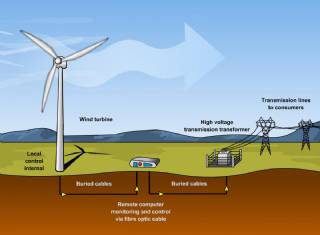
According to BWEA, the British Wind Energy Authority, in the UK currently there are 2896 large Wind turbines with installed capacity of 4532 MW, sufficient to supply over 2.5 million homes (based on annual household energy consumption of 4.7 MWh).
Much attention has been paid recently to Renewables as a potential source of fuel. The rising oil price and the logistics in supplying fossil fuel to remote areas are the main drive to Renewables as well as the environmental incentive. In remote locations, stand-alone Renewable energy systems can be more cost-effective than extending a power line to the electricity grid. In addition, the environmental benefits under the current international concerns on global warming makes such project much more valuable and rewarding.
The growth of renewable energy sources also stimulates employment, the creation of new technologies and new skills.
The new Directive on renewable energy sets ambitious targets for all Member States, such that the EU will reach a 20% share of energy from renewable sources by 2020 and a 10% share of renewable energy specifically in the transport sector. It also improves the legal framework for promoting renewable electricity, requires national action plans that establish pathways for the development of renewable energy sources including bioenergy, creates cooperation mechanisms to help achieve the targets cost effectively and establishes the sustainability criteria for Biofuels. The new Directive should be implemented by Member States by early in 2010.
In a recent statement, Ed Miliband, UK Secretary of State for Energy and Climate change he spelled out the government strategy:
“Transforming the country into a cleaner, greener and more prosperous place to live is at the heart of our economic plans for 'building Britain’s future' and ensuring the UK is ready to take advantage of the opportunities ahead”.
By 2020:
- More than 1.2 million people will be in green jobs.
- 7 million homes will have benefited from whole house makeovers, and more than 1.5 million households will be supported to produce their own clean energy.
- Around 40 percent of electricity will be from low-carbon sources, from Renewables, nuclear and clean coal.
- We will be importing half the amount of gas that we otherwise would.
- The average new car will emit 40 percent less carbon than now.
Labels
wind turbinewind powerrenewable energywind generatorgreen energyrenewable energy sourceswind turbine costhome wind turbinealternative energy sourceswindmillsmall wind turbinewind turbine generatorFarming Principle: Deep Soil Preparation
Looking at GB as a three-legged stool, deep soil preparation is one of the legs. Deep soil preparation builds soil and soil structure by loosening the soil to a depth of 24 inches (60 cm). Ideal soil structure has both pore space for air and water to move freely and soil particles that hold together nicely.

Smart Home Ecosystem - Smart Home Automation - Smart Home Security - Smart Home Technology
The outer-most level corresponds to the individual devices and sensors that consumers interact with. Several candidates are vying for the role of a leader introducing smart home services to the mass market.

Solar Energy Systems - Solar Modules - Solar Electric System Design - Solar Power
The heart of a photovoltaic system is the solar module. Many photovoltaic cells are wired together by the manufacturer to produce a solar module. When installed at a site, solar modules are wired together in series to form strings. Strings of modules are connected in parallel to form an array.
Solar Energy Systems - Array Mounting Racks - Solar Ray - Solar Panel - PV Racks and Mounts
Arrays are most commonly mounted on roofs or on steel poles set in concrete. In certain applications, they may be mounted at ground level or on building walls. Solar modules can also be mounted to serve as part or all of a shade structure such as a patio cover. On roof-mounted systems, the PV array is typically mounted on fixed racks, parallel to t

Solar Energy Systems - Grounding Equipment
Grounding equipment provides a well-defined, low-resistance path from your system to the ground to protect your system from current surges from lightning strikes or equipment malfunctions. Grounding also stabilizes voltages and provides a common reference point. The grounding harness is usually located on the roof.
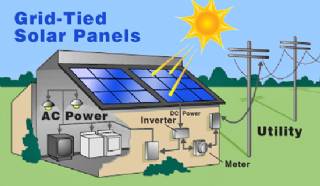
Solar Energy Systems - Solar Inverter - Solar Panel Inverter
Most grid-connected inverters can be installed outdoors, while most off-grid inverters are not weatherproof. There are essentially two types of grid-interactive inverters: those designed for use with batteries and those designed for a system without batteries.
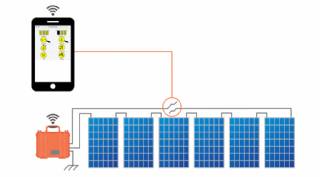
Solar Energy Systems - Solar Disconnects
Automatic and manual safety disconnects protect the wiring and components from power surges and other equipment malfunctions. They also ensure the system can be safely shut down and system components can be removed for maintenance and repair.
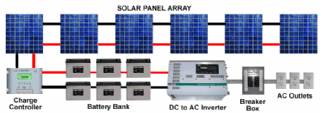
Solar Energy Systems - Solar Battery Bank
Batteries store direct current electrical energy for later use. This energy storage comes at a cost, however, since batteries reduce the efficiency and output of the PV system, typically by about 10 percent for lead-acid batteries. Batteries also increase the complexity and cost of the system.

Solar Energy Systems - Solar Charge Controller
A charge controller, sometimes referred to as a photovoltaic controller or battery charger, is only necessary in systems with battery back-up. The primary function of a charge controller is to prevent overcharging of the batteries. Most also include a lowvoltage disconnect that prevents over-discharging batteries. In addition, charge controllers pr
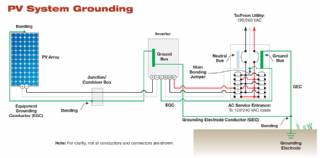
Solar Energy Systems - The NEC and PV Systems
Solar PV systems must be installed in accordance with Article 690 of the National Electric Code, which specifically deals with PV systems, as well as several other articles of the NEC that pertain to electrical systems in general. When there is a conflict between NEC 690 and any other article, NEC 690 takes precedence due to the unique nature of PV